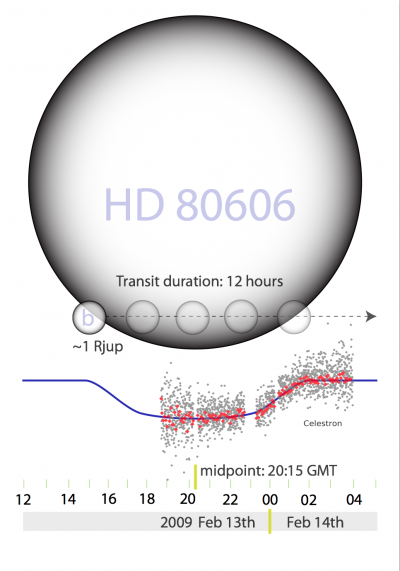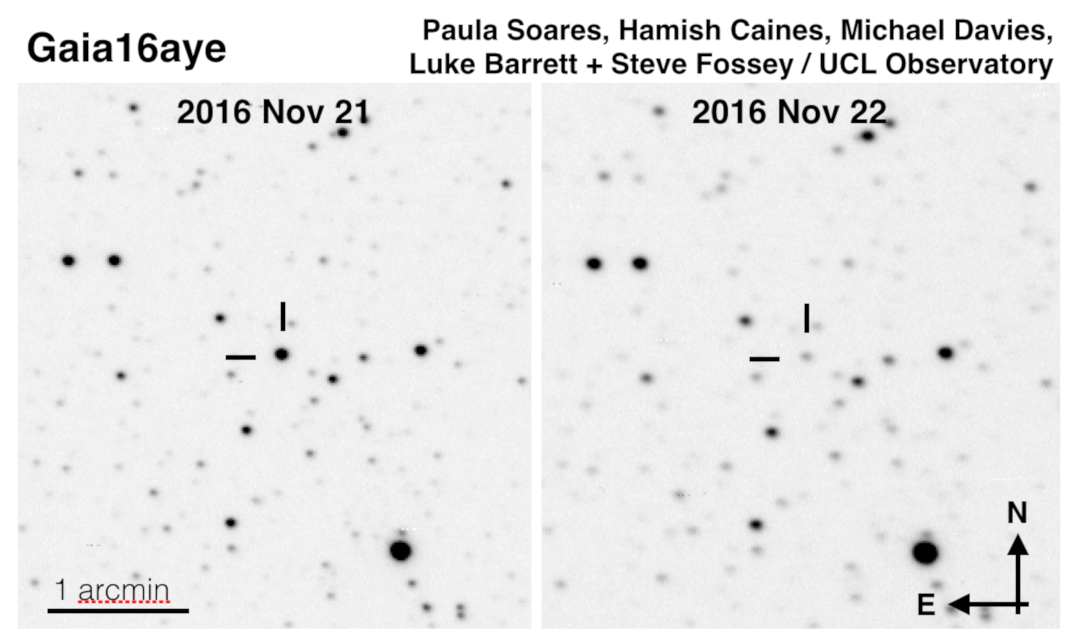
The accurate measurement of light (photometry) from astrophysical sources enables us to investigate different objects in the Universe, from planetary satellites, through extrasolar planets, to distant supernovae. [The plot above shows the change in brightness observed as Triton, one of Neptune's moons, occults (passes in front of) a background star (data recorded on 5 October 2017 by a team of staff and undergraduate students).]
- Exoplanet Transits
We have regularly observed the transits of extrasolar planets using UCLO telescopes. From the light curves obtained, one can constrain physical parameters of the exoplanet, such as the planet radius and tilt of its orbit.
One of our early successes was the independent discovery of the transit of the unusual exoplanet known as HD80606b, which moves in a highly eccentric orbit with period 111 days: observations were carried out through the night of Feb 13-14, 2009, by a team of staff and undergraduate students, and the resulting light curve provided important constraints on the nature of the exoplanet system. An illustration of the light curve is shown below.

Observations of the transits of other exoplanet systems have been made, often by final-year undergraduate project students who have investigated specific aspects of different exoplanet systems; many of our students who got their first experience of exoplanet science using UCLO observations have progressed to doctoral research programmes in exoplanet science, at UCL and elsewhere.
UCLO observations of exoplanet transits have been published in the discovery of the transit of HD80606b (Fossey, Waldmann & Kipping, 2009); and in the announcement of the discovery of the WASP-33b exoplanet system (Collier Cameron et al., 2010).
- Microlensing
We monitor the brightness variations exhibited by microlensing sources, where stars are seen to change brightness due to the amplification of light by the gravitational field of a (generally, unseen) foreground object; we have concentrated in particular on those microlensing events triggered by the Gaia Photometric Science Alerts. We contributed data for the monitoring of the light curve of the unusual binary microlensing events known as Gaia16aye (Wyrzykowski et al., A&A submitted): the rapid fade in the source brightness during a so-called `caustic crossing', as observed in UCLO images obtained on the Celestron 35-cm telescopes by undergraduate students, is shown below.

- Supernovae
The nearby Type Ia supernova known as SN2014J in the galaxy Messier 82 was discovered during a routine undergraduate teaching session at UCLO on January 21, 2014. The image shows a colour composite obtained on the night of 23-24 January (image credit: Prof. Ian Howarth), with the supernova indicated.

The supernova was discovered serendipitously by Dr. Steve Fossey and a team of undergraduate students - Ben Cooke, Guy Pollack, Matt Wilde and Tom Wright - during an undergraduate training session on the C14 telescope. Steve's presentation of the story of the discovery, and its importance, are available in the UCL Lunch Hour lecture that he gave in October 2014:
YouTube Widget Placeholderhttps://www.youtube.com/watch?v=JFOPIIXTltA
 Close
Close

